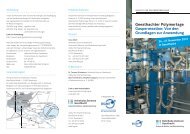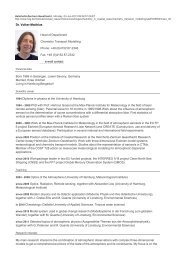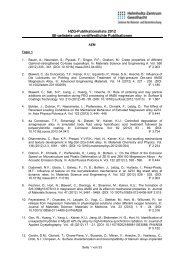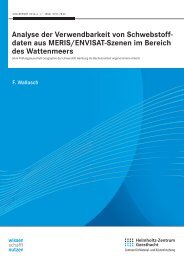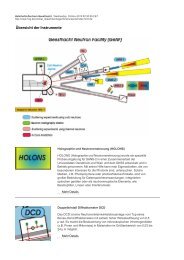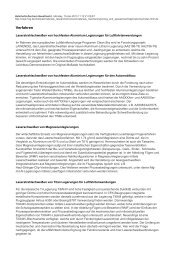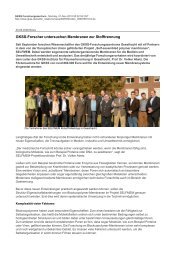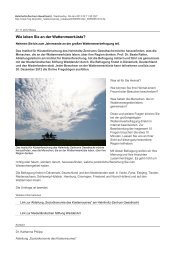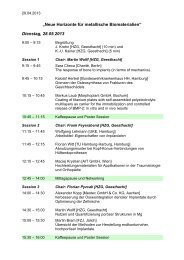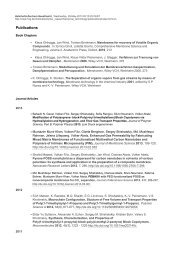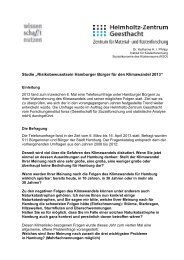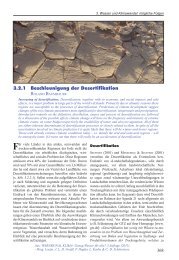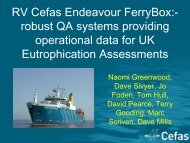High-resolution wave climate analysis in the Helgoland area - GKSS
High-resolution wave climate analysis in the Helgoland area - GKSS
High-resolution wave climate analysis in the Helgoland area - GKSS
Create successful ePaper yourself
Turn your PDF publications into a flip-book with our unique Google optimized e-Paper software.
3.2 Wave model<strong>in</strong>g with empirical downscal<strong>in</strong>g techniques 29<br />
same time, <strong>the</strong> correspond<strong>in</strong>g correlations are found. Usually, <strong>the</strong> major part of <strong>the</strong> jo<strong>in</strong>t<br />
variability is expla<strong>in</strong>ed by first few patterns. As soon as <strong>the</strong>se patterns are constructed, one<br />
variable can be reconstructed from ano<strong>the</strong>r one with a certa<strong>in</strong> error level. The magnitude<br />
of <strong>the</strong> error depends, <strong>in</strong> particular, on how much variability of each field is expla<strong>in</strong>ed by<br />
<strong>the</strong> used patterns. The higher <strong>the</strong> expla<strong>in</strong>ed variance and <strong>the</strong> correlation between <strong>the</strong> correspond<strong>in</strong>g<br />
coefficients, <strong>the</strong> lower <strong>the</strong> rate of <strong>the</strong> error. For more details see Appendix A.2.<br />
In <strong>the</strong> Analog method one variable is reconstructed from ano<strong>the</strong>r us<strong>in</strong>g a pool of typical<br />
situations.<br />
For both CCA and Analog methods <strong>the</strong> medium-scale HF 3-hourly significant <strong>wave</strong><br />
heights at <strong>the</strong> locations around <strong>the</strong> islands were used as predictors. The local KMH 3hourly<br />
significant <strong>wave</strong> heights were used as predictand. Aga<strong>in</strong>, <strong>the</strong> available data was split<br />
<strong>in</strong>to tra<strong>in</strong><strong>in</strong>g (1990-1994) and validation (1995-2001) periods. For <strong>the</strong> CCA <strong>the</strong> number<br />
of degrees of freedom was reduced by apply<strong>in</strong>g <strong>the</strong> empirical orthogonal functions (EOF)<br />
(e.g. von Storch and Zwiers [1999]) (for <strong>the</strong> basic concept see Appendix A.1), which have<br />
been computed for <strong>the</strong> HF and <strong>the</strong> KMH SWH anomaly fields. For <strong>the</strong> HF dataset <strong>the</strong><br />
lead<strong>in</strong>g two EOFs expla<strong>in</strong> about 99.1% of <strong>the</strong> total SWH anomaly variance, for <strong>the</strong> Kmodel<br />
dataset <strong>the</strong> expla<strong>in</strong>ed variance is about 98.3%. Canonical correlation patterns were<br />
subsequently computed based on <strong>the</strong> lead<strong>in</strong>g two EOFs. In Figure 3.2 <strong>the</strong> first two CCA<br />
patterns for KMH and HF are shown. The first set of patterns expla<strong>in</strong>s 97.4% of <strong>the</strong> total<br />
variance for <strong>the</strong> KMH dataset and 98% of <strong>the</strong> variance for HF, <strong>the</strong> correlation between <strong>the</strong><br />
amplitude time-series of <strong>the</strong>se patters is 0.997. So, it appears that <strong>the</strong> first CCA patterns<br />
expla<strong>in</strong> most of <strong>the</strong> variance and correspond<strong>in</strong>g time-series are highly correlated, show<strong>in</strong>g<br />
<strong>the</strong> strong dependency between regional and local SWH patterns. For both KMH and HF<br />
<strong>the</strong> coefficients of <strong>the</strong> first pattern are of <strong>the</strong> same sign, larger values appear <strong>in</strong> <strong>the</strong> western<br />
part of <strong>the</strong> <strong>area</strong> and smaller values appear to <strong>the</strong> east from <strong>the</strong> islands. Physically this<br />
means, that <strong>the</strong> changes <strong>in</strong> SWH occur simultaneously and are more <strong>in</strong>tensive <strong>in</strong> <strong>the</strong> western<br />
part of <strong>the</strong> model doma<strong>in</strong>, which is consistent with <strong>the</strong> <strong>wave</strong> height spatial distribution for<br />
westerly w<strong>in</strong>ds (Fig. 3.1c). The second set of CCA patterns is bipolar and, probably, has<br />
this structure because of <strong>the</strong> request of orthogonality for <strong>the</strong> patterns prescribed by <strong>the</strong> CCA<br />
procedure. The correlation of <strong>the</strong> time-series is 0.65, it expla<strong>in</strong>s 0.6% of <strong>the</strong> KMH fields<br />
variance and 1.1% of HF SWH variance. For <strong>the</strong> CCA reconstruction both patterns were<br />
used, which totally expla<strong>in</strong> about 99% of variability for both datasets. F<strong>in</strong>ally, <strong>the</strong> 3-hourly<br />
SWH fields for <strong>the</strong> validation period have been derived on <strong>the</strong> basis of <strong>the</strong>se patterns.<br />
For <strong>the</strong> analog method a pool of analogs was constructed from <strong>the</strong> 3-hourly SWH fields<br />
1990-1994 of <strong>the</strong> KMH h<strong>in</strong>dcast and <strong>the</strong> correspond<strong>in</strong>g pr<strong>in</strong>cipal components of <strong>the</strong> lead<strong>in</strong>g<br />
two EOFs of <strong>the</strong> 3-hourly HF SWH anomaly field. Subsequently an analog for each date of<br />
<strong>the</strong> validation period was determ<strong>in</strong>ed. For this, <strong>the</strong> HF SWH data of <strong>the</strong> validation period<br />
was projected onto <strong>the</strong> first two EOFs for <strong>the</strong> fitt<strong>in</strong>g period and for each pair of pr<strong>in</strong>cipal<br />
components obta<strong>in</strong>ed <strong>the</strong> nearest pair (analog) from <strong>the</strong> tra<strong>in</strong><strong>in</strong>g period was determ<strong>in</strong>ed.<br />
The KMH <strong>wave</strong> height field belong<strong>in</strong>g to this pair was <strong>the</strong>n selected as <strong>the</strong> analog <strong>wave</strong><br />
height field for <strong>the</strong> correspond<strong>in</strong>g date <strong>in</strong> <strong>the</strong> validation period.



